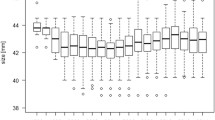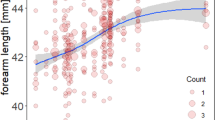Abstract
Our understanding of the complex process of aging has benefitted greatly from experimental evolution. The traditional animal models for human aging, however, are all characterized by “fast” life-histories, with rapid development, short lifespan and intensive, early investment in reproduction. This is in sharp contrast to the characteristics of the human life history and so may lead to inappropriate extrapolations about processes important in human aging. In response to these challenges and for better understanding and intervening in processes fundamental to aging in humans, I propose programs of experimental evolution for both delayed reproduction and for accelerated development in a bat species with a significantly slower life history than traditional animal models for human aging.
Similar content being viewed by others
References
Austad, S. N. (1993a). Retarded senescence in an insular population of Virginia opossums (Didelphis virginiana). Journal of Zoology (London), 229, 695–708.
Austad, S. N. (1993b). The comparative perspective and choice of animal models in aging research. Aging Clinical and Experimental Research, 5, 259–267.
Ball, Z. B., Barnes, R. H., & Visscher, M. B. (1947). The effects of dietary caloric restriction on maturity and senescence, with particular reference to fertility and longevity. American Physiological Society, 150, 511–519.
Barrick, J. E., & Lenski, R. E. (2013). Genome dynamics during experimental evolution. Nature Reviews Genetics, 14, 827–839.
Barrick, J. E., Yu, D. S., Yoon, S. H., Jeong, H., Oh, T. K., Schneider, D., Lenski, R. E., & Kim, J. F. (2009). Genome evolution and adaptation in a long-term experiment with Escherichia coli. Nature, 461, 1243–1247.
Berry, R. J. (1970). The natural history of the house mouse. Field Studies, 3, 219–262.
Bronson, F. H. (1989). Mammalian reproductive biology. Chicago, IL: University of Chicago Press.
Brunet-Rossinni, A. K., & Austad, S. N. (2004). Ageing studies on bats: a review. Biogerontology, 5, 211–222.
Burnham, T. C., Dunlap, A., & Stephens, D. W. (2015). Experimental evolution and economics. SAGE Open, 5, 2158244015612524.
Calder, W. A. (1990). Avian longevity and aging. In D. E. Harrison (Ed.), Genetic effects on aging. II. Caldwell, NJ: Telford Press.
Chippindale, A. K., Chu, T. J., & Rose, M. R. (1996). Complex trade-offs and the evolution of starvation resistance in Drosophila melanogaster. Evolution, 50, 753–766.
Chippindale, A. K., Hoang, D. T., Service, P. M., & Rose, M. R. (1994). The evolution of development in Drosophila melanogaster selected for postponed senescence. Evolution, 48, 1880–1899.
Chippindale, A. K., Leroi, A. M., Kim, S. B., & Rose, M. R. (1993). Phenotypic plasticity and selection in Drosophila life-history evolution. Nutrition and the cost of reproduction. Journal of Evolutionary Biology, 6, 171–193.
Comfort, A. (1979). The biology of senescence (3rd ed.). Edinburgh: Churchill Livingston.
Conn, P. M. (2011). Handbook of models for human aging. San Diego: Academic Press.
Davis, W. H., & Hitchcock, H. B. (1994). A new longevity record for Myotis lucifugus. Bat Research News, 35, 61.
de Grey, A. D. (2005). The unfortunate influence of the weather on the rate of ageing: Why human caloric restriction or its emulation may only extend life expectancy by 2–3 years. Gerontology, 51, 73–82.
Edney, E. B., & Gill, R. W. (1968). Evolution of senescence and specific longevity. Nature, 220, 281–282.
Ellison, P. T. (2009). On fertile ground: A natural history of human reproduction. Cambridge, MA: Harvard University Press.
Finch, C. E. (1990). Longevity, senescence, and the genome. Chicago, IL: University of Chicago Press.
Finch, C. E., Pike, M. C., & Witten, M. (1990). Slow mortality rate accelerations during aging in some animals approximate that of humans. Science, 249, 902–905.
Fleming, T. H. (1988). The short-tailed fruit bat: A study in plant–animal interactions. Chicago: University of Chicago Press.
Garland, T. Jr. (2003). Selection experiments: An under-utilized tool in biomechanics and organismal biology. Vertebrate Biomechanics and Evolution, 23–56.
Garland, T, Jr., & Rose, M. R. (2009). Experimental evolution: Concepts, methods, and applications of selection experiments. Berkeley, CA: University of California Press.
Graves, J. L. (1993). The costs of reproduction and dietary restriction: Parallels between insects and mammals. Growth, Development, and Aging, 57, 233–249.
Harshman, L. G., & Hoffmann, A. A. (2000). Laboratory selection experiments using Drosophila: What do they really tell us? Trends in Ecology & Evolution, 15, 32–36.
Holehan, A. M., & Merry, B. J. (1985). Modification of the oestrous cycle hormonal profile by dietary restriction. Mechanisms of Ageing and Development, 32, 63–76.
Holmes, D. J. (2004). Naturally long-lived animal models for the study of slow aging and longevity. Annals of the New York Academy of Sciences, 1019, 483–485.
Holmes, D. J., & Austad, S. N. (1995). Birds as animal models for the comparative biology of aging: A prospectus. The Journals of Gerontology, 50, B59–B66.
Humphrey, S. R., & Cope, J. B. (1976). Population ecology of the little brown bat, Myotis lucifugus, in Indiana and north-central Kentucky. Special Publication, American Society of Mammalogist, 4, 1–81.
Jurgens, K. D., & Prothero, J. (1987). Scaling of maximal lifespan in bats. Comparative Biochemistry and Physiology, 88A, 361–367.
Kaplan, H., Hill, K., Lancaster, J., & Hurtado, A. M. (2000). A theory of human life history evolution: diet, intelligence, and longevity. Evolutionary Anthropology: Issues, News, and Reviews, 9, 156–185.
Lager, C., & Ellison, P. T. (1990). Effect of moderate weight loss on ovarian function assessed by salivary progesterone measurements. American Journal of Human Biology, 2, 303–312.
Larson, W. A., Seeb, L. W., Everett, M. V., Waples, R. K., Templin, W. D., & Seeb, J. E. (2014). Genotyping by sequencing resolves shallow population structure to inform conservation of Chinook salmon (Oncorhynchus tshawytscha). Evolutionary Applications, 7, 355–369.
Le Bourg, É. (2010). Predicting whether dietary restriction would increase longevity in species not tested so far. Ageing Research Reviews, 9, 289–297.
Lindstedt, S. L., & Calder, W. A. (1976). Body size and longevity in birds. Condor, 78, 91–94.
Luckinbill, L. S., Arking, R., Clare, M. J., Cirocco, W. C., & Buck, S. A. (1984). Selection for delayed senescence in Drosophila melanogaster. Evolution, 38, 996–1003.
Masoro, E. J. (2005). Overview of caloric restriction and ageing. Mechanisms of Ageing and Development, 126, 913–922.
Mattison, J. A., Colman, R. J., Beasley, T. M., Allison, D. B., Kemnitz, J. W., Roth, G. S., Ingram, D. K., Weindruch, R., De Cabo, R., & Anderson, R. M. (2017). Caloric restriction improves health and survival of rhesus monkeys. Nature Communications, 8, 1–12.
Medawar, P. B. (1946). Old age and natural death. Modern Quarterly, 1, 30–56.
Medawar, P. B. (1952). An unsolved problem of biology. London: H.K. Lewis.
Merry, B. J., & Holehan, A. M. (1981). Serum profiles of LH, FSH, testosterone and 5\(\alpha \)-DHT from 21 to 1000 days of age in ad libitum fed and dietary restricted rats. Experimental Gerontology, 16, 431–444.
Munshi-South, J., & Wilkinson, G. S. (2010). Bats and birds: exceptional longevity despite high metabolic rates. Ageing Research Reviews, 9, 12–19.
Partridge, L., & Fowler, K. (1992). Direct and correlated responses to selection on age at reproduction in Drosophila melanogaster. Evolution, 46, 76–91.
Partridge, L., Prowse, N., & Pignatelli, P. (1999). Another set of responses and correlated responses to selection on age at reproduction in Drosophila melanogaster. Proceedings of the Royal Society of London, Series B, 266, 255–261.
Phelan, J. P. (1992). Genetic variability and rodent models of human aging. Experimental Gerontology, 27, 147–159.
Phelan, J. P., & Rose, M. R. (2005). Why dietary restriction substantially increases longevity in animal models but won’t in humans. Aging Research Reviews, 4, 339–350.
Phelan, J. P., & Rose, M. R. (2006). Caloric restriction increases longevity substantially only when the reaction norm is steep. Biogerontology, 7, 161–164.
Pomeroy, D. (1990). Why fly? The possible benefits for lower mortality. The Biological Journal of the Linnean Society, 40, 53–65.
Rasweiler, J. J, I. V., & Badwaik, N. K. (1996). Improved procedures for maintaining and breeding the short-tailed fruit bat (Carollia perspicillata) in a laboratory setting. Laboratory Animals, 30, 171–181.
Roper, C., Pignatelli, P., & Partridge, L. (1993). Evolutionary effects of selection at age of reproduction in larval and adult Drosophila melanogaster. Evolution, 47, 445–455.
Rose, M. R. (1984). Laboratory evolution of postponed senescence in Drosophila melanogaster. Evolution, 38, 1004–1010.
Rose, M. R., & Charlesworth, B. (1981). Genetics of life history in Drosophila melanogaster. II. Exploratory selection experiments. Genetics, 97, 187–196.
Service, P. M., Hutchinson, E. W., MacKinley, M. D., & Rose, M. R. (1985). Resistance to environmental stress in Drosophila melanogaster selected for postponed senescence. Physiological Zoology, 58, 380–389.
Sohal, R. S., & Forster, M. J. (2014). Caloric restriction and the aging process: A critique. Free Radical Biology and Medicine, 73, 366–382.
Stearns, S. C. (1992). The evolution of life histories. Oxford: Oxford University Press.
Stearns, S. C. (2000). Life history evolution: Successes, limitations, and prospects. Naturwissenschaften, 87, 476–486.
Stearns, S. C., Kaiser, M., Ackermann, M., & Doebeli, M. (2000). The evolution of intrinsic mortality, growth, and reproduction in fruitflies. Proceedings of the National Academy of Sciences of the United States of America, 97, 3309–3313.
Wattiaux, J. M. (1968). Parental age effects in Drosophila pseudoobscura. Experimental Gerontology, 3, 55–61.
Weindruch, R., & Walford, R. L. (1988). The retardation of aging and disease by dietary restriction. Springfield, IL: Charles C. Thomas.
Wiersma, P., Muñoz-Garcia, A., Walker, A., & Williams, J. B. (2007). Tropical birds have a slow pace of life. Proceedings of the National Academy of Sciences of the United States of America, 104, 9340–9345.
Wilkinson, G. S., & South, J. M. (2002). Life history, ecology and longevity in bats. Aging Cell, 1, 124–131.
Williams, G. C. (1957). Pleiotropy, natural selection, and the evolution of senescence. Evolution, 11, 398–411.
Author information
Authors and Affiliations
Corresponding author
Rights and permissions
About this article
Cite this article
Phelan, J.P. Generating insights into human aging from experimental evolution using bats (or other “slow” life history species). J Bioecon 20, 165–173 (2018). https://doi.org/10.1007/s10818-017-9262-y
Published:
Issue Date:
DOI: https://doi.org/10.1007/s10818-017-9262-y




